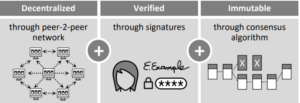Blockchain, the innovative technology that powers the digital currency market, has gained prominence since the introduction of the cryptocurrency bitcoin in 2008. Soon after, banking institutes and financial markets began adopting blockchain to increase security and mitigate risks. Now, companies are starting to apply blockchain technology to improve supply chain management.
What Is Blockchain?
A blockchain is a digitized, decentralized, public ledger (basically, a database) that allows for information on a product going through multiple parties to be tracked in a transparent, trustworthy and verifiable way. Each time a product changes in composition or ownership, a new block of information is added on top of the previous information (thus making a chain). Each block is encrypted, comes with a key code and contains all the previous blocks’ information. Additionally, to add a new block, the information has to be approved by hundreds of decentralized computers based on the rules for the blockchain. This means even if a hacker could break the encryption and try to change or edit information in previous blocks, they would have to hack hundreds of computers around the world at the same time. Everyone can track the origins of a product from beginning to end.

Figure 1: Basic Properties of a Blockchain (reference)
In recent years, blockchain applications have flourished in both large multi-national companies and small start-ups. Maersk, a Danish shipping company, is testing blockchain to improve the administrative procedures and efficiency of marine shipping. In their example, shipping one container of flowers from Kenya to Rotterdam involves about 200 documents, from the local mills and export authorities to the port workers, customs agents and distributors. Tracking the status of goods is still documented manually, which is expensive and inefficient, so Maersk is turning to blockchain to create an efficient digitized workflow. Through blockchain, individual stakeholders can see which documents are still needed, electronically sign them using smart contracts and track the status of the flowers themselves.

Figure 2. Outlook of the Integration of IBM Blockchain for Maersk (source)
While IBM is using blockchain to improve transparency in supply chains for internal stakeholders, start-ups such as Provenance and Everledger are using blockchain to provide supply chain transparency directly to consumers. Everledger, for example, traces the origin of diamonds from provenance and verifies authenticity for consumers using blockchain. This is a step forward in providing consumers with a transparent view of a product’s history.
While blockchain prevents information from being changed or tampered with, blockchain itself does can not guarantee the validity of the initial information placed on it. This is still dependent upon the credibility and reputation of the entities that are placing the information on blockchain to begin with.
Even with consumers believing the information on blockchain, knowing exactly which mine your diamond came from or what cargo ship your flowers were transported in, only temporarily satiates the curiosity of the information-age consumer. Since supply chain scandals started breaking out in the 1990s, consumers have become increasingly interested in learning about the conditions in which their products were made, not just where.
Using existing blockchain platforms, we can know where a diamond was mined, cut and transported. Imagine if these platforms were also able to verify the supply chain and provide information on how environmentally sustainable the mining process was and how employees of all suppliers were treated. Combining the transaction transparency of blockchain with the EcoVadis CSR assessment, we could attach a sustainability scorecard for each of the parties involved at each stage of the supply chain. This would allow consumers to purchase flowers based on the environmental impact of their harvest conditions, the fairness with which employees were treated and good ethical behavior of companies along the supply chain rather than just price and country of origin.
Adding the EcoVadis score to blockchain would provide increased trust by verifying the supply chain, and give consumers in-depth information about the sustainability of each production step. Even though blockchain applications are merely in their infancy, we can already see the benefits in trust and transparency that this technology could bring to supply chains in combination with the EcoVadis assessment.
About the Author
Follow on Twitter Follow on Linkedin Visit Website






















